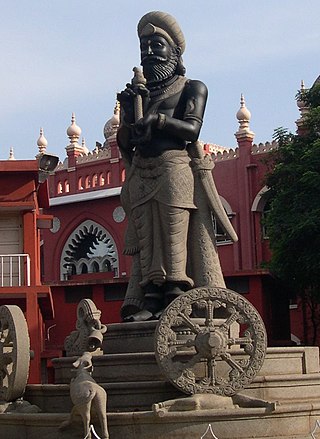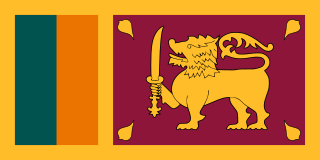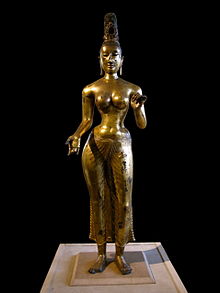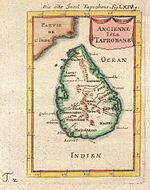
The history of Sri Lanka is intertwined with the history of the broader Indian subcontinent and the surrounding regions, comprising the areas of South Asia, Southeast Asia and the Indian Ocean. The early human remains found on the island of Sri Lanka date to about 38,000 years ago.

Anuradhapura is a major city located in north central plain of Sri Lanka. It is the capital city of North Central Province and the capital of Anuradhapura District. The city lies 205 kilometers (127 mi) north of the current capital of Colombo in the North Central Province, on the banks of the historic Malwathu Oya. The city is now a World Heritage Site famous for its well-preserved ruins of the ancient Sinhalese civilization.

Dutugamunu the Great, also known as Dutthagamani Abhaya, was a king of the Anuradhapura Kingdom who reigned from 161 BC to 137 BC. He is renowned for first uniting the whole island of Sri Lanka by defeating and overthrowing Elara, the usurping Tamil prince from the Chola Kingdom, who had invaded the Anuradhapura kingdom in 205 BC. Dutugamunu also expanded and beautified the city of Anuradhapura and projected the power of the Rajarata kingdom across the island of Sri Lanka.

Mahāvaṃsa (Sinhala: මහාවංශ, Pali: මහාවංස is the meticulously kept historical chronicle of Sri Lanka until the period of Mahasena of Anuradhapura. It was written in the style of an epic poem written in the Pali language. It relates the history of Sri Lanka from its legendary beginnings up to the reign of Mahasena of Anuradhapura covering the period between the arrival of Prince Vijaya from India in 543 BCE to his reign and later updated by different writers. It was first composed by a Buddhist monk at the Mahavihara temple in Anuradhapura in the 5th century CE.

Theravada Buddhism is the largest and official religion of Sri Lanka, practiced by 70.2% of the population as of 2012. Practitioners of Sri Lankan Buddhism can be found amongst the majority Sinhalese population as well as among the minority ethnic groups. Sri Lankan Buddhists share many similarities with Southeast Asian Buddhists, specifically Myanmar Buddhists and Thai Buddhists due to traditional and cultural exchange. Sri Lanka is one of five nations with a Theravada Buddhist majority. Buddhism serves as a pivotal bridge uniting these two nations and civilizations. In response to King Devanampiya Tissa's appeal, Emperor Ashoka dispatched his offspring, Arhat Mahinda and Theri Sangamitta, to disseminate the teachings of Lord Buddha. This gesture reinforced the enduring people-to-people bond and the mutual Buddhist heritage shared between India and Sri Lanka.

Ellalan was a member of the Tamil Chola dynasty in Southern India, also known as "Manu Needhi Cholan", who upon capturing the throne became king of the Anuradhapura Kingdom, in present-day Sri Lanka, from 205 BCE to 161 BCE.

Tissa, later Devanampiya Tissa, was one of the earliest kings of Sri Lanka based at the ancient capital of Anuradhapura from 307 BC to 267 BC. His reign was notable for the arrival of Buddhism in Sri Lanka under the aegis of the Mauryan Emperor Ashoka the Great. The primary source for his reign is the Mahavamsa, which in turn is based on the more ancient Dipavamsa.

Dakkhina Stupa is a 2nd-century BC large brick Stupa in Anuradhapura, Sri Lanka. Earlier thought to be a monument of King Elara, it was later identified as the Stupa of ancient Dakini (Dakkhina) Vihara by Senarath Paranavithana with the help of a Brahmi inscription of the 3rd century A.D. unearthed from the ground between the southern and western Vahalkadas of the Stupa.

Anuradhapura Kingdom, named for its capital city, was the first established kingdom in ancient Sri Lanka related to the Sinhalese people. According to the Mahāvaṃsa, it was founded by King Pandukabhaya in 437 BC, whose authority extended throughout the country.
Valagamba, also known as Wattagamani Abhaya and Valagambahu, was a king of the Anuradhapura Kingdom of Sri Lanka. Five months after becoming king, he was overthrown by a rebellion and an invasion from South India, but regained the throne by defeating the invaders fourteen years later. He is also known for the construction of the Abhayagiri Dagaba.
Mahinda V was King of Anuradhapura in the 11th century. He was the last king of the Anuradhapura Kingdom as well as from the House of Lambakanna II. In 993, he fled to Ruhuna, the southern part of the country, when a Chola invasion led by Rajaraja Chola I captured Anuradhapura. He was later taken prisoner and taken to India, where he died as a prisoner in 1029. The Mahavamsa records that the rule of Mahinda V was weak and he was unable to even organize the collecting of taxes. The country was in a state of extreme poverty and his army refused to follow orders due to lack of wages.
The Battle of Vijithapura was a decisive battle fought in the campaign carried out by Sri Lankan king Dutthagamani against the invading South Indian king Ellalan. The battle is documented in detail in the ancient chronicles of the country. However, they only provide the viewpoint of Dutthagamani and his army, and details are scarce on Elara's side.

The Chola conquest and occupation of Anuradhapura Kingdom was a military invasion of the Kingdom of Anuradhapura by the Chola Empire. It can be seen as an ensuing conflict between Chola and Sinhalese kings after the initial conflict between Chola and the Pandya-Sinhalese alliance during conquest of the Pandya Kingdom by Chola king Paranthka I. After the defeat, Pandya king Rajasimha took his crown and the other regalia and sought refuge in Anuradhapura. The Paranthka made several futile attempts to regain regalia, including invasion of Sri Lanka on a date between 947 and 949 CE during the reign of Sinhalese king Udaya IV. Therefore, one of the driving motives behind the invasions of Anuradhapura by the Cholas' was their desire to possess these royal treasures. The conquest started with the invasion of the Anuradhapura Kingdom in 993 CE by Rajaraja I when he sent a large Chola army to conquer the kingdom and absorb it into the Chola Empire. Most of the island was subsequently conquered by 1017 CE and incorporated as a province of the vast Chola empire during the reign of his son Rajendra Chola I. The Chola occupation would be overthrown in 1070 CE through a campaign of Sinhalese Resistance led by Prince Kitti, a Sinhalese royal. The Cholas fought many subsequent wars and attempted to reconquer the Sinhalese kingdom as the Sinhalese were allies of their arch-enemies, the Pandyas. The period of Chola entrenchment in northern Sri Lanka lasted in total about three-quarters of a century, from roughly 993 CE to 1070 CE, when Vijayabahu I recaptured the north and expelled the Chola forces restoring Sinhalese sovereignty.

Rajarata [rā dja ra tə] was one of three historical regions of the island of Sri Lanka for about 1,700 years from the 6th century BCE to the early 13th century CE. Several ancient cities, including Tambapanni, Upatissa Nuwara, Anuradhapura and Polonnaruwa, were established as capitals within the area by successive rulers. Rajarata was under the direct administration of the King. Two other areas, Malayarata and Ruhunurata, were ruled by the king's brothers "Mapa" and "Epa". The Magha invasion in the 13th century brought about the end of the Rajarata kingdom.
Ilanaga, also known as Elunna, was King of Anuradhapura in the 1st century, whose reign lasted from 38 to 44. He overthrew and succeeded his aunt Sivali as King of Anuradhapura and was succeeded by his son Chandamukha.

The House of Vijaya was the first recorded Sinhalese royal dynasty that ruled over the island, Sri Lanka. According to Sri Lankan historical literature Prince Vijaya is the traditional first king of Sri Lanka, founding the Kingdom of Tambapanni and the dynasty subsequently founding the Kingdom of Upatissa Nuwara and finally the Anuradhapura Kingdom.

This is a bibliography of works on Sri Lanka.

The Sinhalese monarchy has its origins in the settlement of North Indian Indo-Aryan immigrants to the island of Sri Lanka. The Landing of Vijay as described in the traditional chronicles of the island, the Dipavamsa, Mahavamsa and Culavamsa, and later chronicles, recount the date of the establishment of the first Sinhala Kingdom in 543 BC when Prince Vijaya, an Indian Prince, and 700 of his followers are claimed to have landed on the island of Sri Lanka and established the Kingdom of Tambapanni. In Sinhalese mythology, Prince Vijaya and followers are told to be the progenitors of the Sinhalese people. However according to the story in the Divyavadana, the immigrants were probably not led by a scion of a royal house in India, as told in the romantic legend, but rather may have been groups of adventurous and pioneering merchants exploring new lands.

The Polonnaruwa period was a period in the history of Sri Lanka from 1017, after the Chola conquest of Anuradhapura and when the center of administration was moved to Polonnaruwa, to the end of the Kingdom of Polonnaruwa in 1232.













